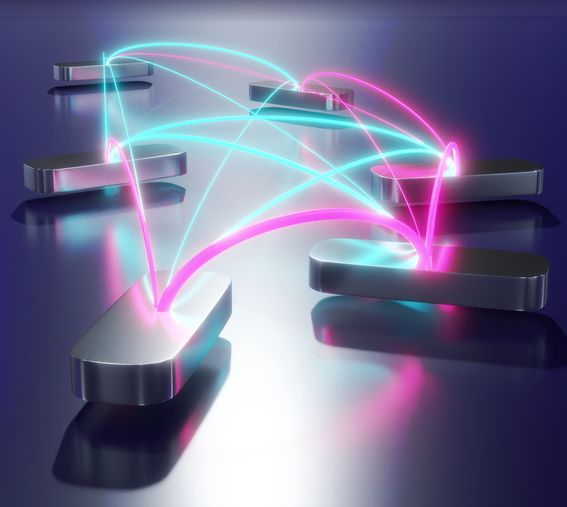Artificial Spin Ice
Geometrically frustrated systems are characterized by highly degenerate low-energy states and have long fascinated the research community, not only because their behavior is hard to predict, but also because their physics can lead to new exotic states of matter. We study thermodynamically active artificial spin ice systems wherein the degree of frustration is tailored by lattice design. The spin ices are fabricated by electron-beam lithography and their magnetic structure is directly visualized by synchrotron-based photoemission electron microscopy (PEEM). Besides the design of frustration in new lattice geometries such as the dipolar trident [2], the square-kite [3], the dipolar Cairo [5], and the trimerized triangular lattices [8], we also provided visual evidence of the formation of screened magnetic charge excitations (polarons) in a dipolar dice lattice [1]. Moreover, we demonstrated real-time imaging of emergent magnetic monopole motion in a macroscopically degenerate 3D square lattice [4]. In this work, we showed that magnetic monopoles are free to evolve within a divergence-free vacuum, a magnetic Coulomb phase, for which features in the form of pinch-point singularities in magnetic structure factors are observed. Recently, we for the first time realized planar triangular antiferromagnetism in an artificial spin system by ordering Ising-type nanomagnets in a quasi-three-dimensional structure [7].

Besides artificial spin ice, we also explore the rich physics of artificial spin glass systems. To realize an artificial spin glass, we randomized the dipolar interactions between Ising-type nanomagnets by mapping the magnets onto Caley trees [6]. In this work, we achieved a maximum effective dimension of 2.72 in finite-sized Cayley, which well exceeds the critical dimension (2.51) for which the spin-glass transition temperature is predicted to be finite. Recently, we realized an artificial spin glass by arranging nanomagnets onto an interaction network that replicates the aspects of a Hopfield neural network [9]. We showed that the temperature dependence of the spin glass correlation function of this system follows a power-law trend predicted from theoretical models on two-dimensional spin glasses. We also observed clear signatures of the hard-to-observe rugged spin glass free energy in the form of sub-aging, out-of-equilibrium autocorrelations, and a transition from stable to unstable dynamics. The realization of a nanomagnetic artificial Hopfield network is an important step towards the implementation of magnetic cognitive computing concepts.
Publications
1. A. Farhan, A. Scholl, C.F. Petersen, L. Anghinolfi, C. Wuth, S. Dhuey, R.V. Chopdekar, P. Mellado, M.J. Alava, S. van Dijken. Thermodynamics of emergent magnetic charge screening in artificial spin ice, Nature Communications 7, 12635 (2016).
2. A. Farhan, C.F. Petersen, S. Dhuey, L. Anghinolfi, Q.H. Qin, M. Saccone, S. Velten, C. Wuth, S. Gliga, P. Mellado, M.J. Alava, A. Scholl, S. van Dijken. Nanoscale control of competing interactions and geometrical frustration in a dipolar trident lattice, Nature Communications 8, 995 (2017).
3. C.F. Petersen, A. Farhan, S. Dhuey, Z. Chen, M.J. Alava, A. Scholl, and S. van Dijken. Tuning magnetic ordering in a dipolar square-kite tessellation. Applied Physics Letters 112, 092403 (2018).
4. A. Farhan, M. Saccone, C.F. Petersen, S. Dhuey, R.V. Chopdekar, Y.-L. Huang, N. Kent, Z. Chen, M.J. Alava, T. Lippert, A. Scholl, S. van Dijken. Emergent magnetic monopole dynamics in macroscopically degenerate artificial spin ice. Science Advances 5, eaav6380 (2019).
5. M. Saccone, K. Hofhuis, Y.L. Huang, S. Dhuey, Z.H. Chen, A. Scholl, R.V. Chopdekar, S. van Dijken, A. Farhan. Dipolar Cairo lattice: Geometrical frustration and short-range correlations. Physical Review Materials 3, 104402 (2019).
6. M. Saccone, K. Hofhuis, D. Bracher, A. Kleibert, S. van Dijken, A. Farhan. Elevated effective dimension in tree-like nanomagnetic Cayley structures. Nanoscale (2020).
7. A. Farhan, M. Saccone, C.F. Petersen, S. Dhuey, K. Hofhuis, R. Mansell, R.V. Chopdekar, A. Scholl, T. Lippert, S. van Dijken. Geometrical frustration and planar triangular antiferromagnetism in quasi-three-dimensional artificial spin architecture. Physical Review Letters 125, 267203 (2020).
8. K. Hofhuis, C.F. Petersen, M. Saccone, S. Dhuey, A. Kleibert, S. van Dijken, A. Farhan. Geometrical frustration and competing orders in the dipolar trimerized triangular lattice. Physical Review B 104, 014409 (2021).
9. M. Saccone, F. Caravelli, K. Hofhuis, S. Parchenko, Y.A. Birkholzer, S. Dhuey, A. Kleibert, S. van Dijken, C. Nisoli, A. Farhan. Direct observation of a dynamical glass transition in a nanomagnetic artificial Hopfield network. Nature Physics 18, 517 (2022).






